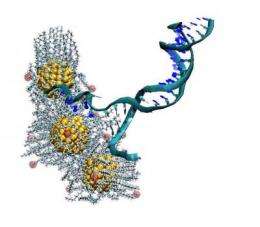Positively-charged ligands on the nanoparticles attach to the DNA, but the hydrophobic ligands of the nanoparticles became tangled with each other. As this tangling pulled the nanoparticles into clusters, the nanoparticles pulled the DNA apart. Credit: Yaroslava Yingling, North Carolina State University
New research from North Carolina State University finds that gold nanoparticles with a slight positive charge work collectively to unravel DNA's double helix. This finding has ramifications for gene therapy research and the emerging field of DNA-based electronics.
"We began this work with the goal of improving methods of packaging genetic material for use in gene therapy," says Dr. Anatoli Melechko, an associate professor of materials science and engineering at NC State and co-author of a paper describing the research. Gene therapy is an approach for addressing certain medical conditions by modifying the DNA in relevant cells.
The research team introduced gold nanoparticles, approximately 1.5 nanometers in diameter, into a solution containing double-stranded DNA. The nanoparticles were coated with organic molecules called ligands. Some of the ligands held a positive charge, while others were hydrophobic – meaning they were repelled by water.
Because gold nanoparticles have a slight positive charge from the ligands, and DNA is always negatively charged, the DNA and nanoparticles are pulled together into complex packages. Credit: Yaroslava Yingling, North Carolina State University
Because the gold nanoparticles had a slight positive charge from the ligands, and DNA is always negatively charged, the DNA and nanoparticles were pulled together into complex packages.
"However, we found that the DNA was actually being unzipped by the gold nanoparticles," Melechko says. The positively-charged ligands on the nanoparticles attached to the DNA as predicted, but the hydrophobic ligands of the nanoparticles became tangled with each other. As this tangling pulled the nanoparticles into clusters, the nanoparticles pulled the DNA apart. Video of the process is below:
"We think gold nanoparticles still hold promise for gene therapy," says Dr. Yaroslava Yingling, an assistant professor of materials science and engineering at NC State and co-author of the paper. "But it's clear that we need to tailor the ligands, charge and chemistry of these materials to ensure the DNA's structural integrity is not compromised."
The finding is also relevant to research on DNA-based electronics, which hopes to use DNA as a template for creating nanoelectronic circuits. Because some work in that field involves placing metal nanoparticles on DNA, this finding indicates that researchers will have to pay close attention to the characteristics of those nanoparticles – or risk undermining the structural integrity of the DNA.
Provided by North Carolina State University

























